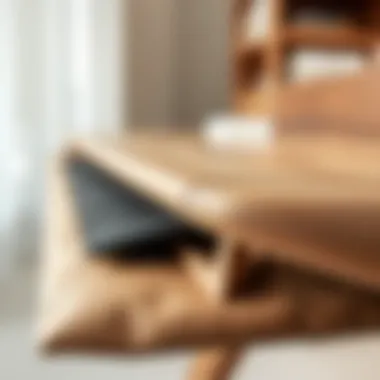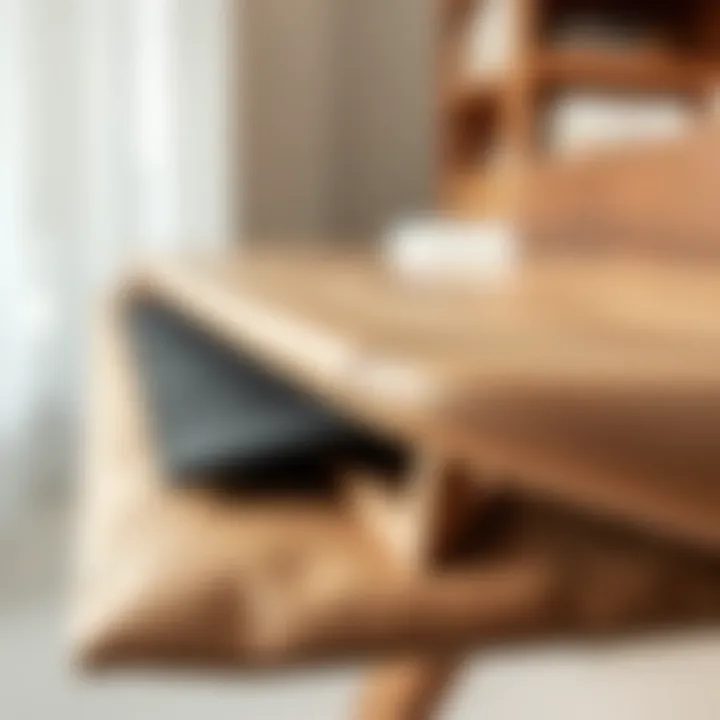Exploring the Versatility of Foldable Kitchen Tables


Intro
In today’s fast-paced world, where space often comes at a premium, foldable kitchen tables and chairs emerge as the unsung heroes of interior design. These ingenious pieces of furniture are not simply functional; they are a testament to the blend of modern style and practicality. With an uptick in urban living and smaller homes, the versatility of foldable furnishings cannot be overstated. This article will delve into the various styles and trends shaping these adaptable items, as well as practical tips for selecting the right pieces for your unique living spaces.
Furniture Styles and Trends
In understanding foldable kitchen furniture, it’s essential to first explore the rich tapestry of styles available today, and how current design trends influence their functionality.
Exploring Popular Furniture Styles
Foldable kitchen tables and chairs come in a multitude of styles catering to diverse tastes. Some prominent options include:
- Minimalist: These designs focus on clean lines and uncluttered forms. Perfect for modern spaces, they often use materials like metal or glass, creating an airy, open feel.
- Rustic: Characterized by natural wood finishes and traditional designs, these pieces bring warmth into a contemporary kitchen, evoking a cozy, inviting atmosphere.
- Industrial: With a mix of metal and wood, industrial-style tables and chairs capture an edgy feel. They often incorporate bold colors and are great for creating a statement within urban settings.
- Contemporary: This style frequently melds different materials and shapes. You'll find unexpected designs that aim to surprise while serving a purpose.
Understanding Current Design Trends
Keeping up with current trends is crucial when selecting foldable furniture. For instance, sustainability is on everyone’s lips. Eco-friendly materials—like bamboo and reclaimed wood—emphasize a commitment to sustainability, and they look good while doing it. Additionally, bold colors and patterns, including geometric shapes, are making waves, allowing homeowners to express their individuality through furniture.
"In a world where every square foot counts, foldable furniture offers freedom and flexibility, catering to both style and function."
Practical Tips for Furniture Selection
Once you’ve narrowed down your style preferences, there are practical considerations to ensure your chosen pieces will harmoniously fit your space.
Factors to Consider When Choosing Furniture
Choosing the right foldable kitchen table and chairs goes beyond aesthetic appeal.
- Material Durability: Understand the wear and tear that comes with daily use. Look for high-quality materials that will stand the test of time, especially if your kitchen is a hub of activity.
- Ease of Use: Ensure that the foldable mechanisms are user-friendly. You don’t want to wrestle with your dining table every time you need it!
- Weight and Size: Consider the size of your kitchen. Opt for pieces that provide sufficient seating and surface area without cramping your style.
How to Measure and Optimize Space
Measuring your space accurately is key to ensuring your furniture selection fits seamlessly into your kitchen. Here’s how to do it:
- Measure your Kitchen Area: Begin by measuring the dimensions where you intend to place the foldable table and chairs.
- Consider the Flow: Ensure that there is enough room to move around the furniture once it’s unfolded. A cramped space can quickly lead to discomfort.
- Think Versatility: Depending on your needs, some pieces might serve multiple functions—like a table that can double as a workstation or a dining area.
By integrating these practical tips with insight into styles and trends, homeowners can maximize the utility and aesthetic appeal of foldable kitchen tables and chairs. The next sections will further unravel the maintenance involved and how to keep these versatile pieces looking their best in any setting.
Prelude to Foldable Kitchen Tables and Chairs
When it comes to maximizing living spaces—especially in the kitchen—foldable tables and chairs emerge as quintessential pieces of furniture. Their flexibility not only provides practicality but also serves the aesthetic needs of today’s homeowners and designers. These multifunctional items help to create a balance between utility and décor, making them integral parts of any modern home.
Definition and Purpose
Foldable kitchen tables and chairs are precisely what they sound like: furniture designed to collapse or fold away when not in use. They serve the dual purpose of functionality and space-saving. In small apartments, compact homes, or bustling kitchens where every inch counts, these versatile pieces ensure that homeowners do not need to compromise between style and practicality.
For instance, imagine hosting a family dinner without the worry of an overcrowded dining area. With the ability to simply fold away tables and chairs after use, one can clear up space for social interaction or even just daily movement around the kitchen. Such functionality makes these items popular in various settings—from cozy homes to chic cafes and even bustling offices, where space optimization is a top priority.
Historical Context
The journey of foldable furniture dates back centuries, and their evolution mirrors the changing dynamics of space and lifestyle in human societies. Originating in various cultures, these pieces were practical solutions for nomadic tribes and later for urban dwellers in burgeoning cities during the Industrial Revolution.
For example, in post-war England, when families were adjusting to smaller living quarters, the demand for easily storable furniture surged. This led to creative designs that catered to compact living, with foldable kitchen tables and chairs becoming highly sought after for their efficiency.
Today, they reflect not just functionality but also the broader trend towards minimalism and sustainability in design. The idea of creating open, multifunctional spaces is more relevant now than ever, where the kitchen serves not only as a cooking hub but also as a gathering spot, a workspace, and sometimes even a reflection of one's personal style.
As consumers become increasingly aware of the importance of adaptability in furniture, foldable kitchen tables and chairs continue to evolve, embracing innovative materials and designs to fit contemporary needs. Their ongoing development not only showcases practicality but also resonates with the narrative of changing lifestyles across generations.
Types of Foldable Kitchen Tables
Foldable kitchen tables come in various designs, each serving unique purposes and catering to different needs. Understanding the types of foldable kitchen tables available is essential for maximizing functionality in modern living spaces. These versatile tables not only save space but also adapt to different styles and requirements, making them a valuable component for homeowners, interior designers, and decorators alike. Here, we delve into three prominent types: wall-mounted options, drop-leaf tables, and extensible folding tables.
Wall-mounted Options
Wall-mounted foldable tables are a remarkable solution for those needing to reclaim precious floor space. They can be securely fixed onto a wall, and when necessary, can be easily folded down to create a functional dining area or workspace. This type of furniture is especially popular in small apartments and studios where space is at a premium.
A few key benefits of wall-mounted tables include:
- Space Efficiency: They don’t require floor space when not in use, allowing for a more open living area.
- Ease of Use: Most designs are straightforward and can be set up or stored away in seconds, accommodating spontaneous dining occasions or when extra workspace is required.
- Design Variety: Wall-mounted tables come in an array of styles, materials, and colors, allowing them to blend seamlessly into any kitchen décor.
However, it’s crucial to consider the wall support needed for these tables. Installation should be careful and secure, ensuring the structure can support weight and daily use. An aesthetic advantage is that, when raised, they can act as wall art in their own right.
Drop-leaf Tables
Drop-leaf tables are an ingenious solution for those who desire a versatile dining setup without taking up too much space. With hinged leaves on either side, a drop-leaf table can be extended to accommodate more people or collapsed when not in use. This flexibility is its biggest strength, making it a popular choice among families and hosts alike.
Consider some of the key advantages:
- Adjustable Size: The ability to expand allows these tables to cater to different group sizes, ideal for casual breakfasts and formal dinners alike.
- Timeless Style: Drop-leaf tables often have a classic look and can fit well with various decor styles, from rustic farmhouse to modern minimalist.
- Compact Storage: When the leaves are down, the table might occupy just enough floor space to fit in tight corners.


One must keep in mind, however, that the pivoting action of the leaves may require additional care to ensure longevity and usability. Regular maintenance checks on hinges ensure they do not become loose or wobbly over time.
Extensible Folding Tables
Extensible folding tables are a convenient blend of portability and adaptability, often featuring extendable mechanisms that allow the tabletop’s length to increase. These tables can be particularly beneficial during gatherings or holiday meals, where the rule of thumb is that the more, the merrier.
The features that stand out with extensible folding tables include:
- Portability: These tables are often lightweight, making them easy to move around as needed. This is a handy feature for homeowners who might want to relocate furniture for different occasions.
- Functional Designs: Many modern extensible tables offer additional features, like integrated storage or stylish finishes that can elevate their aesthetic appeal.
- Versatile Use: Beyond dining, they can serve as a work table for crafts or projects, providing utility all year round.
Nonetheless, the complexity of the extending mechanism must be noted. Users should be cautious to follow the manufacturer’s instructions to prevent damage to the folding mechanisms.
Materials Used in Foldable Kitchen Furniture
The materials chosen for foldable kitchen tables and chairs play a significant role in determining their durability, aesthetics, and functionality. Each material has its unique properties that can cater to different styles and preferences in home design. The choice of materials is not just about looks; it influences aspects like weight, ease of storage, and the overall lifespan of the furniture. In the quest to find the perfect foldable kitchen piece, understanding the pros and cons of these materials becomes essential.
Wood Variants and Their Aesthetics
When it comes to kitchen furniture, wood is often the go-to choice for many homeowners. It brings a warmth and texture into a space that few other materials can match. From oak to maple, there lies a wide array of wood variants, each offering distinct aesthetics and characteristics.
Solid wood options, like cherry or walnut, stand out with their rich grains and robust nature. They are not only pleasing to the eye but also offer a strong foundation for everyday use. However, one must consider the maintenance; these materials may require regular treatments to keep them looking pristine. On the other hand, engineered wood—such as plywood or particle board—may be more budget-friendly. While they often come with a veneer finish that resembles solid wood, they might not hold up to wear and tear as well.
- Durability: Solid wood is typically more durable but also heavier, which may affect portability.
- Aesthetic Appeal: Wood provides a classic look that can match various interior styles, from rustic to contemporary.
- Maintenance: Wooden furniture often demands more upkeep, such as polishing or oiling, depending on the finish used.
Metal Frames for Durability
Metal frames are a solid contender in the foldable furniture sector. They scream durability and can withstand significant weight without warping. Aluminum and steel are popular choices—each with its own set of advantages. Aluminum, being lighter, is easier to maneuver, making it ideal for those who need to set up and dismantle their furniture frequently. Steel, however, offers an incredible strength-to-weight ratio, lending itself well to commercial environments or for heavier applications.
Features of metal frames include:
- Corrosion Resistance: Many metal tables are finished with protective coatings, allowing them to resist rust, even in humid kitchen environments.
- Low Maintenance: Compared to wood, metal requires less maintenance. A simple wipe-down with a damp cloth often suffices.
- Modern Aesthetics: Metal can offer a sleek and sophisticated look that fits well in modern designs, often paired well with glass or wood tops for added style.
Innovative Composite Materials
In recent years, composite materials have begun edging their way into the foldable furniture market. These materials blend different substances to harness the strengths of each, providing a compelling alternative to traditional options.
A common example is a combination of wood fibers and plastics, creating a lightweight yet strong material that resists scratches and is easy to clean.
Other innovative options include HPL (High-Pressure Laminate), which combines layers of resin and decorative paper to form a durable surface resistant to stains and heat. This can be especially beneficial for foldable kitchen tables, where space and usability converge.
- Lightweight: Many composite materials are lighter than solid wood or metal, making them easier to handle.
- Versatility: They can mimic the appearance of wood or stone, providing aesthetic flexibility without the drawbacks of traditional materials.
- Sustainability: Many composites are made from recycled materials, making them a more eco-friendly choice for the environmentally conscious consumer.
"Choosing the right materials can make all the difference in the longevity and appearance of foldable kitchen furniture."
By understanding and selecting the appropriate materials for foldable kitchen tables and chairs, homeowners can make informed decisions that accurately reflect their personal style and practical needs.
Features and Benefits
Foldable kitchen tables and chairs have gained notable traction in modern interior design and home functionality. Their unique characteristics address several concerns that arise in homes of various sizes, particularly those with limited space. The significance of features and benefits in this realm cannot be overstated, as they encapsulate the core motivations for choosing these versatile pieces of furniture.
Space-Saving Solutions
One of the most compelling reasons to opt for foldable furniture is their ingenious capacity for saving space. In times when urban living spaces are shrinking, having the ability to collapse a table or chair when not in use becomes invaluable. Foldable tables can be neatly tucked into corners or against walls, instantly transforming a cramped kitchen into a more open area.
- Versatile Use: When guests visit, simply unfold the table and add chairs to accommodate more people
- Efficient Footprint: No more tripping over furniture in a busy kitchen.
The adaptability is clear. It gives homeowners and renters the power to transform their spaces according to their immediate needs, making daily routines more efficient.
Multi-functionality
With multifunctionality at the forefront of minimalist living, foldable tables and chairs easily wear multiple hats. They’re not just dining surfaces; they can serve as desks, crafting stations, or even extra room for games on movie nights. The integration of various functionalities into a single piece reduces the need for additional furniture, ultimately cutting down on clutter.
Imagine hosting a lively dinner party—your dining table becomes a buffet for hors d'oeuvres. Once the last guest leaves, it might wind up as your craft space or work desk the next day. This capability allows for seamless transitions between different activities without constricting the living environment.
Ease of Storage
When it comes to ease of storage, foldable kitchen furniture shines bright. Unlike traditional furniture that occupies significant square footage, foldable options can be stored away, freeing up valuable space. This becomes essential in multi-use areas.
- Quick Collapse: With a simple flick of a wrist, foldable tables go from functional to compact.
- No Heavy Lifting: Most foldable designs are lightweight, meaning you’re not wrestling with bulky items each time you store them.
Additionally, the ease with which these pieces can be stored translates to less wear and tear. When items aren’t in constant use, they maintain their aesthetics and functionality longer, making them a wise investment for those keen on sustainable living.
In summary, foldable kitchen tables and chairs serve more than just a decorative role in a home. They provide essential solutions for space management, multifunctionality, and storage ease, making them an essential element in contemporary home design. Embracing these features not only enhances the functionality of living spaces but also promotes a lifestyle that is fluid and adaptable to the rhythms of everyday life.
Design Considerations
When it comes to selecting foldable kitchen tables and chairs, thoughtful design considerations are paramount. These pieces are not merely transient elements of a home’s design; they serve both functional and aesthetic roles that shape the overall living environment. The key benefits of incorporating well-designed foldable furniture into a kitchen extend well beyond mere aesthetics. What makes these design elements even more critical is their impact on comfort, style, and practical usability.
Ergonomics and Comfort
In the context of foldable kitchen furniture, ergonomics takes center stage. The goal is to ensure that every piece not only fits into your space but also supports comfortable use. When evaluating different options, pay attention to the height of tables and the design of seating. Ideally, a dining chair should allow for a natural sitting posture while providing adequate back support. Many foldable chairs today feature contoured seats and backrests aimed at enhancing comfort during long meals or family gatherings. Investing in ergonomically sound designs mitigates discomfort, making for a more pleasurable dining experience.


Given that many people use their kitchens for activities beyond just eating—like cooking projects or even homework—having a comfortable setup means flexibility in functionality. Manufacturers often rely on user feedback to enhance designs. Therefore, looking for adjustable or customizable options can help accommodate various body types and heights, which in turn promotes health and well-being.
Style Versatility
The modern homeowner craves versatility in their decor. Foldable kitchen tables and chairs come in a myriad of styles, making it easy to find a fit, no matter the theme of your kitchen. This adaptability ensures that you can showcase both your personality and practical needs simultaneously.
From rustic farmhouse looks to sleek, contemporary designs, the options are virtually limitless. Adjustable elements, mixed materials, and inventive shapes can blend effortlessly with other furniture pieces in your home. For instance, a wooden drop-leaf table can harmonize beautifully with metal chairs, striking a balance between cozy and modern. This style flexibility makes foldable furniture an excellent choice for frequent redecorators or those who appreciate an evolving aesthetic.
Color and Finish Options
The color palette and finish of foldable kitchen furniture can significantly influence the ambiance of the space. When you choose colors that resonate with your personal style, it not only enhances the visual appeal but can also affect your mood while using the space. Bright, bold colors can create an energizing atmosphere, while soft neutrals foster relaxation.
Additionally, various finishes—ranging from matte to gloss—can affect perceptions of space. A glossy finish might bring an elegant touch, while a matte look could evoke warmth and comfort. It's wise to explore natural finishes, like wood stains, for a classic appearance that melds well with traditional kitchens, while metallic paints may better suit modern decor enthusiasts.
Moreover, opting for weather-resistant finishes can ensure that the furniture stands the test of time, both in appearance and durability. This approach not only preserves the furniture’s innate beauty but also reduces the chance of wear and fading over time, ensuring a lasting investment.
Thoughtful design is not just about aesthetics—it's about creating livable, comfortable, and functional spaces that cater to your lifestyle.
Ultimately, considering ergonomics, style versatility, and color options are essential steps in selecting foldable kitchen furniture. These factors contribute to a well-rounded, appealing setup that does more than just occupy space—it becomes an integral part of your home.
Current Trends in Foldable Kitchen Furniture
In the fast-evolving world of home design, foldable kitchen furniture is riding a wave of innovation and practicality. As more people live in urban areas where space is at a premium, the demand for versatile, adaptable furniture is skyrocketing. The trends in foldable kitchen tables and chairs not only reflect changing lifestyles but also cater to a growing awareness of sustainability and technology. This section highlights some current trends that are defining the market, offering insights into their importance.
Sustainable Practices
Sustainability is firmly at the forefront of design today. Consumers are increasingly concerned about the environmental impact of their purchases, so manufacturers are responding accordingly. When it comes to foldable kitchen furniture, sustainable practices can encompass:
- Material Sourcing: Many brands are opting for reclaimed wood, or responsibly sourced materials, which reduces the impact on forests and promotes eco-friendly consumption.
- Production Methods: Innovations in manufacturing are reducing waste. For instance, companies are utilizing advanced techniques that minimize leftover materials, promoting a cleaner production cycle.
- Durability and Longevity: Investing in high-quality foldable furniture ensures longevity, which discourages the throwaway culture. Products designed for durability end up being more cost-effective over time, aligning with consumer values focused on sustainability.
These sustainable practices not only benefit the planet but also resonate with consumers who prioritize ethical consumption.
Smart Furniture Technology
The rise of smart technology has transformed several aspects of our lives, and furniture design is no exception. With a focus on convenience and efficiency, smart furniture is becoming a key trend in foldable kitchen items. Some notable features include:
- Integrated Charging Stations: Many foldable tables now come with built-in USB ports or wireless charging options, making it easy to power up devices without clutter.
- App Connectivity: Certain pieces can be connected to home automation systems via apps. This lets users control lighting, adjust heating, or even monitor the kitchen environment right from their furniture.
- Modular Designs: Smart technology facilitates modular designs which can be customized according to needs. For instance, tables that can adjust in height or shape depending on how many people are using them.
Such technology does not only add a contemporary flair but also appeals to tech-savvy homeowners looking for efficiency in every corner of their living spaces.
Minimalist Approaches
The trend towards minimalism has also made a significant mark in the foldable furniture sector. Simplistic designs that prioritize functionality and ease of use are gaining traction. Key aspects of this trend include:
- Streamlined Aesthetic: Foldable tables and chairs are designed with clean lines, neutral colors, and understated elegance, making them suitable for a variety of home styles.
- Space-Efficient Designs: With multifunctional capabilities, these pieces can shift from dining areas to workspaces, featuring designs that are easy to fold and store away when not in use.
- Reduced Clutter: By embracing a minimal approach, homeowners can maintain a serene living environment that feels spacious even in smaller kitchens.
The minimalist approach isn’t just about looking good; it’s about optimizing space without sacrificing style or comfort.
"Folding furniture represents the intersection of practicality and design, ensuring that functionality does not come at the expense of aesthetics."
As we move forward, these trends in foldable kitchen furniture will pave the way for more designs that focus on flexibility, comfort, and sustainability. Homeowners and interior designers alike will benefit from these developments, enabling them to create versatile spaces that truly reflect modern living.
Accessibility Features
Foldable kitchen tables and chairs have become indispensable in modern homes, particularly as they cater to a diverse population, including individuals with disabilities or mobility issues. Accessibility in furniture design is more than a trend; it’s a necessary consideration that can significantly enhance the usability of a space. In this section, we will explore how foldable kitchen furniture embodies inclusivity through thoughtful design principles aimed at offering ease of use, convenience, and comfort.
User-friendly Designs
User-friendly design is at the heart of creating functional foldable kitchen furniture. This involves not just aesthetics but also the furniture's capacity to serve everyone, regardless of their physical capabilities. For example, a foldable table that can be easily adjusted in height might appeal especially to someone who uses a wheelchair. The option to lower or raise the table eliminates the need for a separate dining area, allowing families to gather without barriers.
Moreover, handles or grips integrated into a chair's design can greatly assist someone with limited upper body strength. A simple mechanism that allows chairs to unfold with minimal effort can make all the difference. All these small yet significant factors contribute to a more accommodating kitchen environment:
- Adjustable height for tables and chairs
- Easy-to-operate mechanisms for folding and unfolding
- Grips and handles for secure movement
The focus should always be on removing hurdles. Seamless usability is the aim, empowering users to enjoy their kitchen spaces without a hitch.
Accommodating Different Needs
Understanding that every individual has unique comfort needs is fundamental to designing foldable kitchen furniture. Not only should the designs take into account physical abilities, but they should also accommodate the preferences of diverse lifestyles. For instance, some might need a wider seat for added comfort, while others might benefit from removable cushions for easier cleaning.
Flexibility is essential. Imagine a kitchen that can morph between a bustling gathering spot and a quiet mealtime nook in an instant��—each foldable piece satisfying various demands. It’s also beneficial if the layouts can be easily reconfigured from a family setup to a more intimate arrangement, proving that foldable furniture is synonymous with adaptability.
- Wider seats for larger individuals or those requiring additional space
- Removable and washable covers for ease of maintenance
- Multi-functional pieces that can serve for dining, studying, or working
Recognizing these needs lets homeowners and designers create effective environments that welcome all, reaffirming the belief that gatherings around the table should never be limited by one’s capabilities.
Accessibility isn’t just about ease; it’s about inclusiveness in every family meal and every shared moment.
Maintenance and Care
Taking care of foldable kitchen tables and chairs might seem like an afterthought, but it is actually a crucial aspect of maintaining their beauty and functionality over time. The wear and tear that comes from daily use can diminish their aesthetic appeal and structural integrity if left unchecked. Well-cared-for furniture not only looks better but also lasts longer, making regular maintenance essential for homeowners who wish to maximize their investment.


Cleaning Techniques
To keep your foldable furniture in top shape, develop a cleaning routine that addresses the specific materials of your pieces.
- Wood Furniture: For wood-based tables and chairs, use a soft cloth dampened with water and a mild soap. Then, wipe down the surfaces gently to avoid scratching. Following this, dry with a clean cloth to prevent moisture damage. Occasionally, applying a quality wood polish can rejuvenate the luster of your surfaces.
- Metal Frames: Metal structures are usually more resilient. A simple wipe with a damp cloth usually suffices. However, for stubborn stains, a mix of vinegar and water can work wonders, as it acts as a natural cleaner. Avoid abrasive materials that might scratch the finish.
- Composite Materials: Since composites can vary, always refer to the manufacturer's guidelines. Generally, a mix of mild soap and water followed by a rinse with clean water is effective. Stay away from harsh chemicals that can degrade the material over time.
"Regular cleaning not only keeps your furniture looking sharp, but it also contributes to a healthier living environment. Dust and grime can harbor allergens, making a simple wipe-down critical for well-being."
Preventive Measures Against Wear
Taking steps to prevent wear before it happens is smarter than reacting after damage occurs. Here are a few strategies:
- Protective Covers: When not in use, consider investing in protective covers made for your specific foldable items. This can shield them from dust, spills, and scratches. Having a dedicated storing space can extend their life remarkably.
- Rotate Use: If your furniture allows for it, rotating its use can prevent uneven wear. For instance, if one side of a table is consistently used, try swapping it periodically with the other side.
- Avoid Excessive Weight: Each piece has a specific weight tolerance. Overloading a table can stress joints, leading to breakage. Be mindful of placing heavy items only on appropriate surfaces.
- Regular Inspections: Every now and then, inspect screws, hinges, and other movable parts to ensure they are well tightened and functioning. This simple task can save major repairs in the long run.
In summary, keeping foldable kitchen furniture in good shape requires consistent care and attention. By employing smart cleaning techniques and taking preventive measures, homeowners can enjoy their versatility and functionality for years to come.
Integrating Foldable Furniture into Home Design
Integrating foldable furniture into home design is like fitting puzzle pieces into an intricate picture. It’s not merely about finding a place for a table or a chair, but about creating harmonious environments that balance utility and aesthetics. In modern homes, space is often a luxury. Foldable furniture, especially in the kitchen, is instrumental in maximizing every corner of a room while offering flexibility that traditional furniture cannot provide. By incorporating these pieces, homeowners can craft spaces that evolve according to their needs.
Creating Functional Spaces
When you think about functionality in the kitchen, foldable tables and chairs can often be the unsung heroes. They adapt beautifully to various activities, whether it’s a quick breakfast or a grand dinner party. Imagine a small dining area where a table can be expanded effortlessly when guests arrive and folded down to make way for daily routines.
**Key Benefits of Functional Folding:
- Versatility:** These pieces can adjust in size and use, fitting almost any occasion and making the most out of limited square footage.
- Space Management: They can be neatly tucked away when not in use, freeing up valuable floor space for other activities.
- Easy Transformation: With a simple motion, the mood of the room can shift from casual to formal, accommodating the changing dynamics of daily life.
Having a well-designed foldable setup in the kitchen allows for quick transitions, making it easier to host impromptu gatherings. It's almost like having a magician's wand at your fingertips, transforming your space as needed.
Combining with Permanent Fixtures
While foldable furniture zips and zags seamlessly into any room, it shines even brighter when paired with permanent fixtures. This combination can add depth and character to the kitchen design. Consider a beautiful granite countertop where a drop-leaf table complements its elegance. The contrasting textures and styles can create an inviting space.
When it comes to integrating these pieces with longstanding elements, here are some consideration to keep in mind:
- Color Coordination: Choose foldable tables and chairs that harmonize with the kitchen’s palette. Deciding on complementary or contrasting colors can help in creating an engaging visual aesthetic.
- Material Compatibility: Ensure that the materials of foldable furniture mesh well with existing fixtures. For instance, if the kitchen showcases rustic wooden cabinets, wooden foldable tables might enhance the overall character.
- Strategic Placement: Positioning your foldable furniture to complement architectural features—like a bay window or an island—enhances both the look and the function of your kitchen.
Combining foldable pieces with permanent fixtures is not just about aesthetics; it’s about crafting a space that flows seamlessly, providing both function and beauty—like a well-written symphony.
By integrating foldable furniture into your home design, you create adaptable spaces that meet the demands of modern living, all while adding aesthetic value.
Ultimately, the incorporation of foldable kitchen tables and chairs allows for a design that is both fluid and constant. With careful thought and planning, these elements can harmonize beautifully within any home, proving that utility and style can indeed reside under the same roof.
Customer Considerations
In the world of home design, especially when it pertains to folding kitchen furniture, recognizing customer considerations is paramount. It shapes the decisions of homeowners, designers, and anyone involved in crafting functional living spaces. Understanding what to look for enables buyers to make informed choices, ensuring they get value that matches both their aesthetic desires and practical needs. Here are some key elements to ponder when shopping for foldable kitchen tables and chairs:
"Your living space needs to reflect who you are. Choosing the right furniture is part of telling that story."
Identifying Personal Needs
When selecting foldable furniture, the first step is to identify personal needs. This involves more than just the dimensions of a room. It’s about how one interacts with that space daily. Some ponder questions like:
- How often do you host gatherings? A larger folding table may be beneficial.
- Is kitchen space at a premium? A compact, wall-mounted option might be the desired choice.
- Are you looking for versatility in usage? Consider tables that can serve both as workspaces and dining areas.
Understanding these factors ensures that the foldable furniture chosen aligns with lifestyle needs. Moreover, additional features like integrated storage or aesthetics should also be weighted carefully. The table shape, chair design, and color can heavily influence the feel of the kitchen. Emphasizing personal needs leads to a more satisfying purchase, making the kitchen not only functional but also an inviting space.
Budget-conscious Options
Once personal preferences are outlined, the next aspect is budget considerations. This doesn’t necessarily mean compromising quality for a lower price. With a plethora of options available, it’s possible to strike a balance between affordability and functionality. Here are some strategies to consider:
- Do thorough research: Websites like reddit.com or forums can provide insights on affordable brands that do not sacrifice quality.
- Look for sales or seasonal discounts: Many manufacturers offer promotions that can significantly cut costs.
- Assess second-hand options: Websites like Facebook Marketplace or local thrift stores often have hidden gems that might suit your needs at a fraction of the cost.
- Consider multifunctional pieces: Investing in a table that can serve multiple purposes can reduce the need for purchasing additional furniture, ultimately saving money.
In summary, customer considerations in the realm of foldable kitchen tables and chairs revolve around personal needs and budget. By understanding and prioritizing what really matters, buyers can navigate the myriad of options effectively, ensuring a good fit for both their space and their purse.
Epilogue and Future Perspectives
As we wrap up this exploration into foldable kitchen tables and chairs, it's clear that these versatile pieces are more than just functional furniture; they embody adaptability and innovation. Their importance in modern kitchens cannot be overstated, especially as living spaces shrink and the need for multi-use items grows. Foldable furniture answers the call for flexibility in a world that often values open space over clutter.
The Evolving Role in Modern Kitchens
Foldable kitchen furniture has found its niche, serving increasingly diverse roles in households today. Families are no longer just looking for a place to eat; rather, they seek environments that can host multiple activities—from family game night to casual brunches with friends. For instance, a foldable table can be expanded for gatherings and then tucked away, allowing the kitchen to easily transition back into a workspace or a play area. It’s not just about saving space, it's about creating seamless transitions between various functions, ensuring that every corner of the kitchen contributes to the overall living experience.
Moreover, as trends lean toward minimalism and functionality, the demand for such adaptable furniture will only rise. Homeowners are more conscientious today about their belongings, preferring items that serve multiple purposes, fit easily into different aesthetic styles, and accommodate a variety of needs. Thus, the growing acceptance of foldable designs enhances their value—not merely as furniture, but as integral elements of a dynamic living environment.
Predictions for Future Designs
Looking ahead, it’s reasonable to speculate that foldable furniture will continue to undergo significant innovations. As technology becomes increasingly integrated into our homes, it’s likely we will see foldable tables and chairs equipped with smart features. Imagine a dining table with a built-in tablet operation for seamless family communication or smart sensors that adjust the table height automatically.
Furthermore, sustainability will play a pivotal role in shaping future designs. As a society, there’s a focus towards eco-friendly materials; bamboo and recycled metals will dominate trends. Furniture designers might even explore bio-based composites that are sturdy yet lightweight, catering to customers who prefer green options without sacrificing quality.
In summary, the role of foldable kitchen tables and chairs will undoubtedly evolve, focusing on user-centric functionality, sustainability, and technology integration. The furniture of tomorrow promises to be smarter, more versatile, and aligned with the values of modern living.
"As we adapt our lifestyles, our furniture must adapt with us, shaping a new era of home design where flexibility and functionality go hand in hand."
By embracing these emerging trends, homeowners, interior designers, and architects can look forward to creating spaces that are not just well-furnished, but thoughtfully designed to enhance the experience of everyday living. The future of foldable furniture is bright—and undoubtedly essential.















